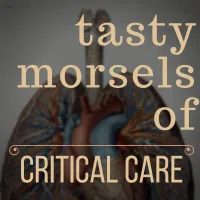Episode Description
Welcome back to the tasty morsels of critical care podcast.
Hypertriglyceridaemua induced pancreatitis came up at a recent trainee presentation and I thought despite it being pretty niche and rare, it’s still common enough that it might be fair game for an SAQ or perhaps a side bar in a viva discussion.
Pancreatitis is of course a common presentation to the ICU and can range from the straightforward to the never ending complication fest that carries a not insubstantial mortality rate. This is not the post that will cover the full gammut of pancreatitis.
So what is the deal with the cumbersomely named “hypertriglycerdiaemia induced pancreatitis”. UTD has the helpful statement that this is the causative factor in “1-35%” of cases of pancreatitis. This tells me nothing except that we don’t know how common it is. In terms of cases coming to your unit you should probably consider it if you can’t find gallstones and they don’t ingest alcohol. It should probably come higher on your differential than scorpion bites for example.
I’ve seen a few of these and the main trigger for the diagnosis was the lab ringing and saying that the blood is so lipaemic that they can’t process it. There are some lovely images online of the bizzare appearance of the blood. It’s one of the few diagnoses you can make by simply looking at the blood as it fills the bottle (the other being methaemogobinaemia)
The higher the trigs, the worse the pancreatitis generally. It may be a familial thing to do with generation and metabolism of trigs or it may be secondary hypertriglyceridaemia due to something common like diabetes or even pregnancy.
How does the fatty stuff cause the pancreatitis? At this stage in the viva expectations will be low – no one expects detail though a complete silence is likely not going to be well received. A statement along the lines of “well now, it’s not the trigs themselves that are toxic but instead the fatty acids produced by lipases that are the precipitating agent”. This is likely to pacify any potential predatory examiner and you can move onto something more relevant like how it might change your management.
Your management will be the same as for almost all pancreatitis with organ support, and some fluids etc…. The subtleties of management of pancreatitis associated with hypertriglyceridaemia are somewhat predictable. You should restrict fats in your nutrition till things are under control. If they’re severe enough to be in ICU they’re often hyperglycaemic and on some insulin already but as we know insulin can help reduce fatty acid release, therefore being aggressive with insulin (maybe in the 5-10 unit/hr range) , and supporting with dextrose if needed, would seem prudent.
The more eye catching therapy that you should be aware of is plasmapheresis. As one can imagine removing all of the plasma from the person will result in removal of the triglycerides from the blood. Indeed a 50-80% reduction is quoted in the available observational studies used to support the practice. There are no RCTs to support its use in this scenario though if you’ve been around for long enough you’ll of course note that most of what we do is not supported by RCT level evidence. Neither the 2013 APA guidance or the 2019 WSES guidance mentions plasmapheresis
Somewhat surprisingly, the classic outpatient lipid drugs like the statins, the fibrates and ezetimibes etc do not seem to play a prominent role in the acute management but are naturally important in prevention of recurrence in the longer term.
Reading
- heavy dependence on the doctor’s little helper here (otherwise known as UTD)
- Oh Chapter 43 covers pancreatitis generally and I am sure we will return here in due course
